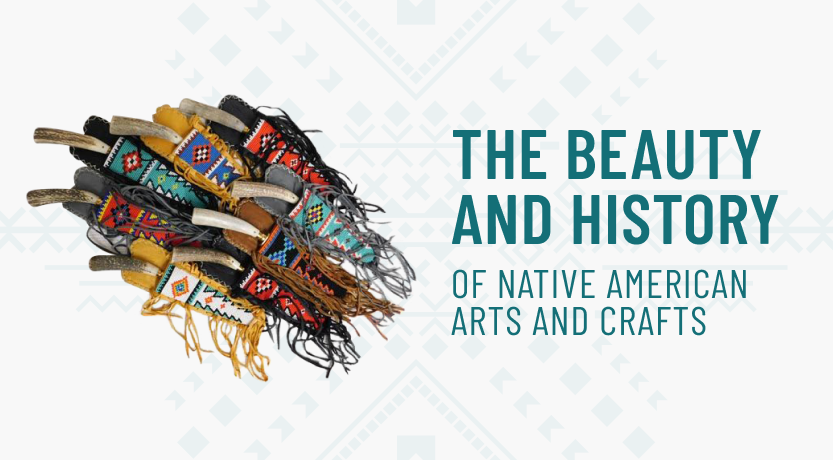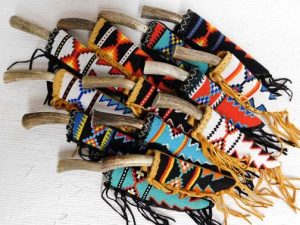
Updated November 2023
Beads play an important role in Native American crafts and designs have become more and more intricate. Today, metal, glass, shells, and stones are used to produce Native American beadwork patterns that are present in fashion and other decorative pieces.
In early times, tribes used simple items from hunted animals to create ornamentation. With the development of stone tools, it became easier to create holes for beads. Eventually, tribes began using semi-precious gemstones as trade routes expanded. For instance, jasper and turquoise were popular and were paired with silver and copper metals. In many ways, beadwork patterns became symbols of wealth. They played key roles in ceremonies, rituals, and celebrations.
Today, Native American beading is found in many artifacts. Each pattern provides a different perspective and stands as a remembrance of tribal traditions.
What Are The Different Types Of Native American Beadwork Styles?
Some beading styles include threads that are used to create patterns for jewelry and other accessories. Some include stitchwork that is placed directly onto the material. Many times, beads are used to create large pictures. Each pattern is unique and involves different stitches.
Lazy Stitch
With this technique, Native Americans use an overlay stitch that includes beads. Everything is attached to the fabric at the ends. This is most commonly used to create large patterns with one color. The number of beads used is one way to identify what tribe completed the project.
Loom Work
Looms are used to create large strips of beads that do not rest on a fabric backing. Usually, these are used to create belts or hair decorations. Originally, these patterns were utilized mostly by the Plains Indians.
Ground Stitch
When a loom or fabric backing is not used, some Native American tribes use a ground stitch to create a design. This includes laying a tube of beads around an object. For example, this stitch is utilized to decorate basket handles and similar objects. With close examination, a person will notice that this pattern has a number of beads that can be evenly divided by three. Keychains and necklaces are often made using this stitch.
Brick Stitch
The brick stitch uses a similar technique to the ground stitch, but it does not have groups of three in the pattern. Also, it remains flat. The beads are arranged horizontally so that the end results are flush with a surface.
Beaded Appliques
Appliques are separate ornaments that are attached to other things. The beaded designs are formed on a small piece of material before being sewn onto something else. Many times, large patterns are formed on a loom. Then, they are placed on backing. Since many appliques can be joined to create a large design, the beading can get quite intricate.
How Do You Identify Native American Beadwork?
Identifying authentic Native American beadwork is a skill that requires a keen eye and some knowledge of the diverse cultural traditions that have produced these stunning creations. Here are some key factors to consider when distinguishing genuine Native American beadwork:
- Materials Used: Traditional Native American beadwork often features natural materials such as bone, stone, shells, wood, clay and flattened metal. Trade beads including glass beads were incorporated after First Contact with Europeans. While contemporary pieces may include a broader range of materials, these traditional elements remain a hallmark of authenticity.
- Color Symbolism: Native American beadwork often incorporates colors that hold specific cultural and symbolic meanings within the community. Understanding the symbolism behind the colors can provide valuable clues about the piece’s origin.
- Design and Pattern: Different tribes have distinct design motifs and patterns that are passed down through generations. Familiarize yourself with the designs associated with specific tribes to identify the cultural origin of the beadwork.
- Stitching Techniques: Pay attention to the stitching technique employed in the beadwork. Each tribe may have a preferred stitching method that leaves characteristic marks or patterns on the piece.
- Consistency: Authentic Native American beadwork exhibits a high level of precision and consistency in the arrangement of beads and patterns. Irregularities may indicate a piece is not traditional or might not be genuine.
- Provenance: Whenever possible, seek information about the history and origin of the piece. Authentic Native American beadwork often comes with documented provenance, providing a clear lineage and ensuring its legitimacy.
- Expertise: Consult with experts in Native American art and culture, such as tribal artisans, museums, or reputable dealers. They can offer valuable insights and guidance in identifying genuine beadwork.
- Trusted Sources: Purchase Native American beadwork from reputable sources and artisans who have a track record of selling authentic, culturally significant pieces. This ensures that you are investing in genuine art and supporting the artisans who create it. When you purchase beadwork pieces from Kachina House, you can be sure you are getting the real thing.
- Cultural Context: Understanding the cultural context of the beadwork can be essential in identifying its authenticity. Learn about the tribe’s history, traditions, and the role of beadwork within their culture.
- Documentation: Authentic Native American beadwork may come with certificates of authenticity or other forms of documentation that verify its origin and cultural significance. Be sure to keep these documents as they can serve as important references.
Uncover the Beauty of Native American Beadwork Patterns

Even though many people are not aware of the history behind Native American bead
patterns, they are fine works of art. If a person wants to appreciate the beauty and tradition behind this beadwork, Kachina House offers a variety of items. For authentic Native American beaded artifacts, it is possible to shop our beautiful selection of handmade jewelry, prayer fans, medicine bags, and knife sheaths.
For some further reading on this, check out Nordic Needle’s blog post about Native American Beadwork!


Hi,
I was wanting to inquire if you had a recommendation on certain books for reference for identifying the certain bread patterns and their meaning.
I believe you mean beadwork patterns. I am sorry, but the patterns are sometimes very personal to the individual artist themselves. Even the sash patterns on the Katsina carvings are very specific, mean specific things and are not shared with outsiders. Good luck in your quest.